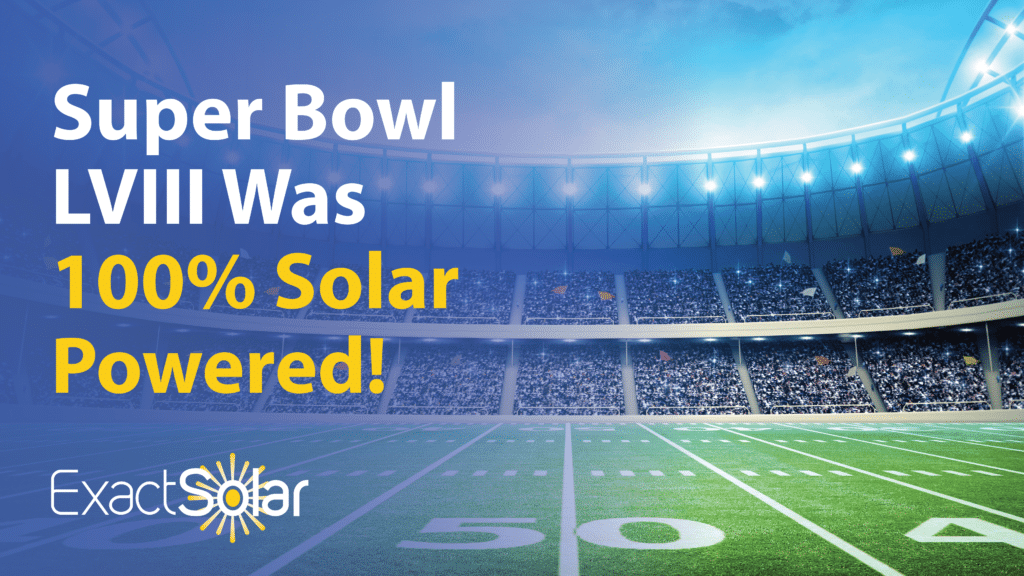
Every nacho fried, hot dog grilled, and beer poured at Super Bowl LVIII was powered entirely by solar energy. You may have seen it in the news leading up to the big game.
Now, we’re happy that the sun powered such a significant event. Watching more stadiums and major sporting events jump on the solar train is exciting.
But, as proud Pennsylvanians watching all this press coverage of their solar-powered stadium unfold, a small part of us wanted to shout:
“Don’t they realize that the Eagles have been doing this for almost a decade?“
Allegiant Stadium is Incredible
Don’t get us wrong, what they’ve done at Allegiant Stadium in Las Vegas is amazing. They’ve managed to draw all of their power from the massive Arrow Canyon Solar Project, which boasts an array of more than 621,000 bifacial solar panels coupled with 564 battery segments.
Arrow Canyon produces enough energy yearly to power 76,000 Nevada homes and offset 632,000 tons of Carbon Dioxide. It powers far, far more than just Allegiant Stadium.
Allegiant Stadium itself is very impressive. On their sustainability page, they show off the fantastic list of accomplishments that got them their LEED Gold certification in 2023, like:
- Waste and food scrap sorting
- Cigarette butt collection (somehow they turn them into energy)
- A biomass machine that composts their grass clippings
- Recycling of rubber turf pellets
- Their energy-efficient roof
- Water management and filtration systems
You get the idea.
It’s an incredible accomplishment.
Super Bowl LVIII required more than 28 megawatt-hours of electricity. That’s equivalent to the energy needed for 46,000 households to watch the game at home.
It sounds impressive and will become more impressive over time as Allegiant Stadium hosts more games and concerts powered by the sun.
Right now, it’s a drop in the ocean compared to the 25.9 gigawatt-hours that Lincoln Financial Field solar array has produced since late 2015, according to the live energy tracker on the Eagles’ website.
It’s hard to wrap your mind around what a massive amount of power this is. According to the live energy tracking site, it’s enough to power 345,252,663.5 hours of light.
The Eagles Were Leed Gold Certified Five Years Ago
The Eagles were into sustainability long before it was cool.
“Since opening Lincoln Financial Field in 2003, we have been steadfast in our commitment to sustainable business practices.”
– Don Smolenski, Philadelphia Eagles President
Twenty-one years ago, before eco-friendly design was widely thought about or accepted, The Eagles were leading the charge.
A decade after construction, Lincoln Financial Field was certified Leed Silver. Then, way back in 2018, the stadium was awarded the coveted Leed Gold certification.
Our home field was the first in the NFL to use solar, wind power, and dual-fuel electricity. They announced their plan to build a solar and wind array on the stadium in 2010 and officially switched it on in late 2015.
Initially, Lincoln Financial Field installed 11,000+ and fourteen windmills as part of a 20-year partnership with NRG. Each of the windmills only produced enough electricity to power a bathroom hand dryer. They looked pretty and were a great marketing tool, but they were removed in 2019.
The solar array is spread across Lincoln Financial Field’s Parking Lot and the upper parts of the stadium roof. All told, the panels generate enough power for 40% of the stadium’s needs, but the facility is powered by 100% renewable energy.
Through a Power Purchase Agreement (PPA) with the utility, Lincoln Financial Field sells all the energy they generate back to their power company, and the company sells them enough clean energy back at a reduced rate to power the entire field.
It Doesn’t Stop There
The Eagles’ commitment to sustainability can be seen throughout the stadium. In one of the entrances, there’s a Lombardi Trophy made of melted-down plastic bottle caps collected throughout the stadium.
99% of Lincoln Financial Field’s trash is recycled, including shrink wrap and all cardboard boxes—more than 1000 tons per year.
They sort all of the aluminum cans out and sit on them until the price of aluminum is high, then sell them all and give the surplus back to their trash-sorting staff as incentives.
As if all of that weren’t enough, Lincoln Financial Field recycles its fry oil into biodiesel. All of the grease used to fry the stadium’s fries and corndogs is converted into fuel for Lincoln Financial Field’s trucks and machinery.
Our Only Question
As we reflect on the twenty-one years of commitment to sustainability that the Lincoln Financial Field’s leadership has shown, we only have one question for Allegiant Stadium:
What took you so long?
